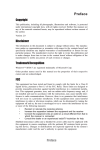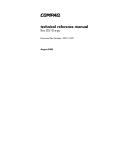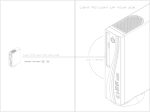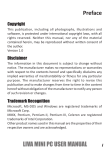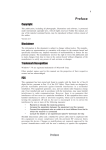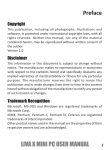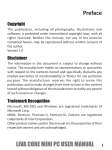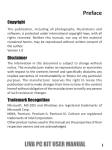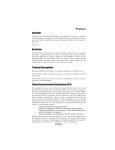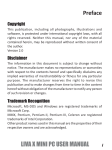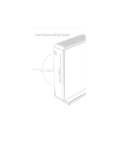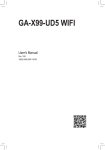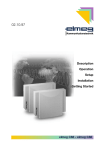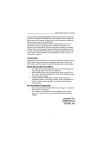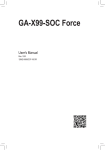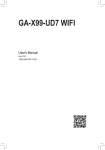Download Untitled
Transcript
i Preface Copyright This publication, including all photographs, illustrations and software, is protected under international copyright laws, with all rights reserved. Neither this manual, nor any of the material contained herein, may be reproduced without written consent of the author. Version 1.0 Disclaimer The information in this document is subject to change without notice. The manufacturer makes no representations or warranties with respect to the contents hereof and specifically disclaims any implied warranties of merchantability or fitness for any particular purpose. The manufacturer reserves the right to revise this publication and to make changes from time to time in the content hereof without obligation of the manufacturer to notify any person of such revision or changes. Trademark Recognition Windows ® VISTA/7 are registered trademarks of Microsoft Corp. Other product names used in this manual are the properties of their respective owners and are acknowledged. Federal Communications Commission (FCC) This equipment has been tested and found to comply with the limits for a Class B digital device, pursuant to Part 15 of the FCC Rules. These limits are designed to provide reasonable protection against harmful interference in a residential installation. This equipment generates, uses, and can radiate radio frequency energy and, if not installed and used in accordance with the instructions, may cause harmful interference to radio communications. However, there is no guarantee that interference will not occur in a particular installation. If this equipment does cause harmful interference to radio or television reception, which can be determined by turning the equipment off and on, the user is encouraged to try to correct the interference by one or more of the following measures: • • • • Reorient or relocate the receiving antenna Increase the separation between the equipment and the receiver Connect the equipment onto an outlet on a circuit different from that to which the receiver is connected Consult the dealer or an experienced radio/TV technician for help Shielded interconnect cables and a shielded AC power cable must be employed with this equipment to ensure compliance with the pertinent RF emission limits governing this device. Changes or modifications not expressly approved by the system’s manufacturer could void the user’s authority to operate the equipment. Preface ii Declaration of Conformity This device complies with part 15 of the FCC rules. Operation is subject to the following conditions: • • This device may not cause harmful interference, and This device must accept any interference received, including interference that may cause undesired operation Canadian Department of Communications This class B digital apparatus meets all requirements of the Canadian Interferencecausing Equipment Regulations. Cet appareil numérique de la classe B respecte toutes les exigences du Réglement sur le matériel brouilieur du Canada. Preface iii Safety Instructions Your system is designed and tested to meet the latest standards of safety for information technology equipment. However, to ensure your safety, it is important that you read the following safety instructions. Setting up your system • • • • • • Read and follow all instructions in the documentation before you operate your system. Do not use this product near water or a heated source such as a radiator. Set up the system on a stable surface. Openings on the chassis are for ventilation. Do not block or cover these openings. Make sure you leave plenty of space around the system for ventilation. Never insert objects of any kind into the ventilation openings. Use this product in environments with ambient temperatures between 0°C and 40°C. If you use an extension cord, make sure that the total ampere rating of the devices plugged into the extension cord does not exceed its ampere rating. Care during use • • • • Do not walk on the power cord or allow anything to rest on it. Do not spill water or any other liquids on your system. When the system is turned OFF, a small amount of electrical currentstill flows. Always unplug all power, modem, and network cables from the power outlets before cleaning the system. If you encounter the following technical problems with the product, unplug the power cord and contact a qualified service technician or your retailer. • • • • • The power cord or plug is damaged. Liquid has been spilled into the system. The system does not function properly even if you follow the operating instructions. The system was dropped or the cabinet is damaged. The system performance changes The warranty does not apply to products that have been disassembled by users Preface iv Safety cautions and warnings Optical Drive Satety Information Optical drive sold with this system contains a CLASS 1 LASER PRODUCT. CAUTION: Invisible laser radiation when open. Do not stare into beam or view directly with optical instructions. WARNING: Makeing adjustments or performing procedures other than those specified in the user’s manual may result in hazardous laser exposuer. Do not attempt to disassemble the optical drive. For your safety, have the optical drive serviced only by an authorized service provider. Product disposal notice INPORTANT: This symbol if the crossed out wheeled bin indicates that the product (electrical and electronic equipment) should not be placed in municipal waste. Check local regulations for disposal of electronic products. Nordic Lithium Cautions (for lithium-ion batteries) CAUTION: Danger of explosoin if battery is incorrectly replace only with the same or equivalent type recommended by the manufacturer. Dispose of used batteries according to the manufacturer’s instructions. Product disposal notice 1. Do not place this product underneath heavy loads or in an unstable position. 2. Do not use or expose this product around magnetic fields as magnetic interference may affect the performance of the product. 3. Do not expose this product to high levels of direct sunlight, highhumidity or wet conditions. 4. Do not block the air vents to this product or impede the airflow in any way. Preface v TABLE OF CONTENTS Preface i Chapter 1 1 Introducing the PC 1 Introduction......................................................................................1 Specification......................................................................................2 Front and Rear I/O............................................................................3 Packing Contents..............................................................................5 Chapter 2 7 Installing the PC 7 System Quick Installing...................................................................7 Chapter 3 11 Using BIOS 11 About the Setup Utility................................................................ 11 The Standard Configuration..............................................11 Entering the Setup Utility...................................................11 Using BIOS......................................................................................12 Standard CMOS Setup......................................................13 Advanced Setup.................................................................15 Advanced Chipset Setup....................................................17 Integrated Peripherals.......................................................18 Power Management Setup.................................................19 PC Health Status................................................................20 Frequency/Voltage Control................................................21 Load Default Settings.........................................................23 Save & Exit Setup...............................................................23 Exit Without Saving............................................................23 vi Chapter 4 25 Using the Software 25 About the Software DVD-ROM/CD-ROM.................................25 Auto-installing under Windows 7...............................................25 Running Setup....................................................................26 Manual Installation........................................................................28 Utility Software Reference............................................................28 1 Chapter 1 Introducing the PC Introducting Thank you for choosing 3.8L MS200 of great performance and with stylish and flexible design. Support Intel® Socket LGA1156 Core i3/i5 Clarkdale processors and a dimension of 270mm (H)* 205mm (D)* 70mm (W), 3.8L SFF provides the features of low power consumption (working with a 120Watt power adaptor), low noise (<30db) and space saving. The chipset is Intel® H55, supporting up to 8 GB of system memory with DDR3 memory SO-DIMM, 3.5” SATA II HDD, Slim DVD Super-multi Tray type/ Tray-load Slim type ODD, and Build in Intel® HD Graphics. Introducing the PC 2 Specification Chipset • Intel® H55 CPU Support • Socket LGA1156 for Intel® Core i3/i5 Clarkdale processors (up to 73W) Memory • 2 x SO-DIMM up to 8 GB Graphics Storage • • Built-in Intel® HD graphics Supported 1 x 3.5” SATA II HDD ODD • Support Slim DVD Super-multi Tray type Front Panel • • • • 4 x USB2.0 1 x Headphone output 1 x MIC-IN 1 x Multi-card reader slot Rear Panel • • • • • • 4 x USB 1 x D-Sub, 1 x HDMI 1 x 10/100/1000 LAN RJ45 1 x TV Tuner (optional) 1 x Antenna (optional) 8 Channel Audio, 6 Jacks Power • 120W power adaptor OS Support • Hardware Compatible with Windows 7 Expansion • 1 x Mini PCIE Dimensions (mm) • 270mm * 205mm * 70mm WARNING: Please realize that there is a certain risk involved with overclocking, Including adjusting the setting in the BIOS, or using the third-party overclocking tools. Overclocking may affect your system stability, or even case damage to the components and devices of your system. It should be done at your own risk and expense. We are not responsible for possible damage casesd by overclocking. Introducing the PC 3 Front and Rear I/O 1. Power Button Press the prower button to turn the system on and off. 2. 4 IN 1 Card Reader Supports SD Card/ MMC Card/ MS Card. You can easily read phone or other files on the momery card. Your digital cameras, DVs, MP3 players or other digital devices are highly compatible. 3. USB Connectors The USB connectors is for attaching USB devices, such as mouse, keyboard, printer, scanner and other USB-compatible device. 4. Mic In Jack Connecting Microphone. 5. Headphone Jack Connecting Headphone. Introducing the PC 4 6. HDMI Connector Connecting HDMI Device. 7. USB Connectors Connecting USB Devices (USB2.0 Ports) 8. Eight channel HD Audio Microphone Jack/ Headphone Jack/ Line In Jack. 9. DC Jack It is used for power adapter 10. Antenna It is used for an optional antenna 11. D-SUB Connector Connecting VGA Monitor. 12. LAN Connecting the Network. 13. TV Tuner (optional) TV in jack. Introducing the PC 5 Packing Contents Driver DVD Manual Stand Power NOTE: Please contact us immediately if any of the items is damaged or missing. Introducing the PC 6 Memo Introducing the PC 7 Chapter 2 Installing the PC System Quick Installation 1. Connecting HDMI device. 2. Connecting VGA Monitor. (D-SUB Connector) 3. The USB connectors is for attaching USB devices, such as mouse, keyboard, printer, scanner and other USB-compatible device. Installing the PC 8 4. Connecting the Network. (LAN Connector) 5. Connecting the Microphone. (Microphone Jack) 6. Connecting Speakers or Headphones. (Headphone Jack) 7. Connecting External Audio Device. (Line In Jack) Installing the PC 9 8. Connecting Power. (DC jack) Installing the PC 10 Memo Installing the PC 11 Chapter 3 Using BIOS About the Setup Utility The computer uses the latest “American Megatrends Inc. ” BIOS with support for Windows Plug and Play. The CMOS chip on the motherboard contains the ROM setup instructions for configuring the motherboard BIOS. The BIOS (Basic Input and Output System) Setup Utility displays the system’s configuration status and provides you with options to set system parameters. The parameters are stored in battery-backed-up CMOS RAM that saves this information when the power is turned off. When the system is turned back on, the system is configured with the values you stored in CMOS. The BIOS Setup Utility enables you to configure: • Hard drives, diskette drives and peripherals • Video display type and display options • Password protection from unauthorized use • Power Management features The settings made in the Setup Utility affect how the computer performs. Before using the Setup Utility, ensure that you understand the Setup Utility options. This chapter provides explanations for Setup Utility options. The Standard Configuration A standard configuration has already been set in the Setup Utility. However, we recommend that you read this chapter in case you need to make any changes in the future. This Setup Utility should be used: • when changing the system configuration • when a configuration error is detected and you are prompted to make changes to the Setup Utility • when trying to resolve IRQ conflicts • when making changes to the Power Management configuration • when changing the password or making other changes to the Security Setup Entering the Setup Utility When you power on the system, BIOS enters the Power-On Self Test (POST) routines. POST is a series of built-in diagnostics performed by the BIOS. After the POST routines are completed, the following message appears: Press DEL to enter SETUP Using BIOS 12 Press the delete key to access the BIOS Setup Utility. CMOS Setup Utility - Copyright (C) 1985-2010, American Megatrends, Inc. fFrequency/Voltage Control fBIOS Security Features fStandard CMOS Setup fAdvanced BIOS Features fAdvanced Chipset Features fIntegrated Peripherals fPower Management Setup f PC Health Status Load Default Setting Save & Exit Setup Exit Without Saving mnlk : Move Enter : Select +/-/: Value F10: Save ESC: Exit F1:General Help F7: Previous Values F9: Optimized Defaults F8: Fail-Safe Defaults Configure Time and Date. Display System Information... v02.67 (C)Copyright 1985-2010, American Megatrends, Inc. Using BIOS When you start the Setup Utility, the main menu appears. The main menu of the Setup Utility displays a list of the options that are available. A highlight indicates which option is currently selected. Use the cursor arrow keys to move the highlight to other options. When an option is highlighted, execute the option by pressing <Enter>. Some options lead to pop-up dialog boxes that prompt you to verify that you wish to execute that option. Other options lead to dialog boxes that prompt you for information. Some options (marked with a triangle f) lead to submenus that enable you to change the values for the option. Use the cursor arrow keys to scroll through the items in the submenu. In this manual, default values are enclosed in parenthesis. Submenu items are denoted by a triangle f . The default BIOS setting for this motherboard apply for most conditions with optimum performance. We do not suggest users change the default values in the BIOS setup and take no responsibility to any damage caused by changing the BIOS settings. BIOS Navigation Keys The BIOS navigation keys are listed below: KEY ESC mnlk +/Enter FUNCTION Exits the current menu Scrolls through the items on a menu Modifies the selected field’s values Select F9 Loads an optimized setting for better performance F10 Saves the current configuration and exits setup F1 Displays a screen that describes all key functions Using BIOS 13 For the purpose of better product maintenance, we reserve the right to change the BIOS items presented in the manual. The BIOS setup screens shown in this chapter are for reference only. Please visit our website for updated manual. Standard CMOS Setup This option displays basic information about your system. CMOS Setup Utility - Copyright (C) 1985-2010, American Megatrends, Inc. Standard CMOS Setup System Date System Time Thu 0101/2009 12 :09 :26 f SATA Port1 f SATA Port2 ATAPI CDROM Hard Disk Help Item Use [ENTER], [TAB] or [SHIFT-TAB] to select a field. Use [+] or [-] to configure system Date. mnlk : Move Enter : Select +/-/: Value F10: Save ESC: Exit F1:General Help F7: Previous Values F9: Optimized Defaults F8: Fail-Safe Defaults System Date & System Time The Date and Time items show the current date and time on the computer. If you are running a Windows OS, these items are automatically updated whenever you make changes to the Windows Date and Time Properties utility. fSATA Port 1~2 This motherboard supports two SATA channels and each channel allows one SATA device to be installed. CMOS Setup Utility - Copyright (C) 1985-2010, American Megatrends, Inc. SATA Port1 Help Item SATA Port1 Device Vendor LBA Mode PIO Mode Async DMA Ultra DMA Type PIO Mode DMA Mode : ATAPI CDROM : Optiarc DVD RW AD-7643S : Supported :4 : MultiWord DMA-2 :Ultra DMA-5 Select the type of the device connected to the system. Auto Auto Auto mnlk : Move Enter : Select +/-/: Value F10: Save ESC: Exit F1:General Help F7: Previous Values F9: Optimzed Defaults F8: Fail-Safe Defaults Using BIOS 14 Type (Auto) Use this item to configure the type of the IDE device that you specify. If the feature is enabled, it will enhance hard disk performance by reading or writing more data during each transfer. PIO Mode (Auto) Use this item to set the PIO mode to enhance hard disk performance by optimizing the hard disk timing. DMA Mode (Auto) DMA capability allows users to improve the transfer-speed and data-integrity for compatible IDE devices. Press <Esc> to return to the Standard CMOS Setup page. Using BIOS 15 Advanced Setup This page sets up more advanced information about your system. Handle this page with caution. Any changes can affect the operation of your computer. CMOS Setup Utility - Copyright (C) 1985-2010, American Megatrends, Inc. Advanced BIOS Features Quick Boot Quiet Boot 1st Boot Device 2nd Boot Device 3rd Boot Device 4th Boot Device f Hard Disk Driver Priority f Optical Disk Driver Priority Bootup Num-Lock Boot Sector Virus Protection USB Beep Message Enabled Enabled Hard Disk Drive CD/DVD Removable Device LAN Press Enter Press Enter On Disabled Disabled Help Item Allows BIOS to skip certain tests while booting. This will decrease the time needed to boot the system. mnlk : Move Enter : Select +/-/: Value F10: Save ESC: Exit F1:General Help F7: Previous Values F9: Optimized Defaults F8: Fail-Safe Defaults Quick Boot (Enabled) If you enable this item, the system starts up more quickly be elimination some of thepower on test routines. Quiet Boot (Enabled) If enabled, BIOS will show a full screen logo at boot; if disabled, BIOS will set the initialdisplay mode to BIOS and show the diagnostic POST screen at boot. 1st/2nd/3rd/4th Boot Device (Hard Drive/CD/DVD/Removable Dev./LAN) Use this item to determine the device order the computer used to look for an operating system to load at start-up time. The devices showed here will be different depending on the exact devices installed on your motherboard. fHard Disk Drive Priority (Press Enter) Scroll to this item and press <Enter> to view the following screen: CMOS Setup Utility - Copyright (C) 1985-2010, American Megatrends, Inc. Hard Disk Driver Priority Help Item Hard Disk Driver 1st Drive SATA: SM-ST3250620AS mnlk : Move Enter : Select F1: General Help Specifies the boot sequence from the available devices. +/-/: Value F10: Save ESC: Exit F9: Optimized Defaults Press <Esc> to return to the Advanced BIOS Features page. Using BIOS 16 fOptical Disk Driver Priority (Press Enter) Scroll to this item and press <Enter> to view the following screen: CMOS Setup Utility - Copyright (C) 1985-2010, American Megatrends, Inc. Optical Disk Driver Priority Help Item Optical Disk Driver 1st Drive CD/DVD: PM-Optiarc D mnlk : Move Enter : Select F1: General Help Specifies the boot sequence from the available devices. +/-/: Value F10: Save ESC: Exit F9: Optimized Defaults Press <Esc> to return to the Advanced BIOS Features page. Boot Up Num-Lock (On) This item defines if the keyboard Num Lock key is active when your system is started. Boot Sector Virus Protection (Disabled) If set to Disabled, when anything attempts to access the boot sector or hard disk partitiontable, there will be no warning message to appear. USB Beep Message (Disabled) This item disables/enables the beep during USB device enumeration. Press <Esc> to return to the main menu setting page. Using BIOS 17 Advanced Chipset Setup This page sets up more advanced information about your system. Handle this page with caution. Any changes can affect the operation of your computer. CMOS Setup Utility - Copyright (C) 1985-2010, American Megatrends, Inc. Advanced Chipset Setup Intel EIST Intel XD Bit Intel VT Memory Hole Remapping Video Memory Size DVMT Mode DVMT/Fixed Memory Size Enabled Enabled Enabled Enabled 32MB DVMT Mode 256MB Help Item When disabled, force the XD feature flag to always return to 0. mnlk : Move Enter : Select +/-/: Value F10: Save ESC: Exit F1:General Help F7: Previous Values F9: Optimized Defaults F8: Fail-Safe Defaults Intel EIST (Enabled) This item allows users to enable or disable the EIST (Enhanced Intel SpeedStep technology). Intel XD Bit (Enabled) This item allows users to enable or disable the Intel XD bit. Intel VT (Enabled) This item allows you to enable or disable the Intel. virtualization Technology (Intel. VT)function. Memory Hole Remapping (Enabled) This item allows users to enable or disable memory hole remapping. Video Memory Size (32MB) This item applies to chipsets/motherboards capable of the HyperMemory Support. DVMT Mode (DVMT Mode) DVMT is Dynamic Video Memory Technology. This item helps you select video mode. DVMT/Fixed Memory Size (256MB) When set to Fixed Mode, the graphics driver will reserve a fixed portion of the systemmemory as graphics memory. When set to DVMT Mode, the graphics chip will dynamicallyallocate system memory as graphics memory, according to system and graphics require-ments. Press <Esc> to return to the main menu setting page. Using BIOS 18 Integrated Peripherals This page sets up some parameters for peripheral devices connected to the system. CMOS Setup Utility - Copyright (C) 1985-2010, American Megatrends, Inc. Integrated Peripherals Onboard SATA Controller Onboard SATA Mode Onboard USB Controller Legacy USB Support Onboard Audio Controller Onboard LAN Controller Onboard LAN Option ROM Enabled Native IDE Enabled Enabled Enabled Enabled Disabled Help Item Options Disabled Enabled mnlk : Move Enter : Select +/-/: Value F10: Save ESC: Exit F1:General Help F7: Previous Values F9: Optimized Defaults F8: Fail-Safe Defaults Onboard SATA Controller (Enabled) This item allows you to enable or disable the onboard SATA controller. Onboard SATA Mode (Native IDE) Use this item to select the mode of the Serial ATA. Onboard USB Controller (Enabled) Enables or disables the onboard USB controller. We recommend users keep the default value. Disabling it might cause the USB devices not to work properly. Legacy USB Support (Enabled) Use this item to enable or disable support for legacy USB devices. Onboard LAN Controller (Enabled) This option allows you to control the onboard LAN device. Onboard LAN Option ROM (Disabled) This item enables or disables the onboard LAN option ROM function. Press <Esc> to return to the main menu setting page. Using BIOS 19 Power Management Setup This page sets up some parameters for system power management operation. CMOS Setup Utility - Copyright (C) 1985-2010, American Megatrends, Inc. Power Management Setup ACPI Aware O/S Suspend mode Deep Power Off Mode Power On by RTC Alarm Power On by PCIE Devices Wake Up by USB KB/Mouse Restore On AC Power Loss Yes S3 (STR) Enabled Disabled Disabled Enabled Last State Help Item Enable/Disable ACPI support for Operating System. Enable: If OS Supports ACPI Disable: If OS does not support ACPI. mnlk : Move Enter : Select +/-/: Value F10: Save ESC: Exit F1:General Help F7: Previous Values F9: Optimized Defaults F8: Fail-Safe Defaults ACPI Aware O/S (Yes) This item supports ACPI (Advanced Configuration and Power management Interface). Use this item to enable or disable the ACPI feature. Suspend Mode (S3 (STR)) Use this item to define how your system suspends. In the default, S3 (STR), the suspendmode is suspend to RAM, i.e., the system shuts down with the exception of a refresh currentto the system memory. Deep Power Off Mode (Disabled) This item allows you to enable/disable the USB device wakeup function from S3/S4 mode. Power On by RTC Alarm (Disabled) The system can be turned off with a software command. If you enable this item, the systemcan automatically resume at a fixed time based on the system¡¯ RTC (realtime clock). Usethe items below this one to set the date and time of the wake-up alarm. You must use an ATXpower supply in order to use this feature. Power On by PCIE Devices (Disabled) The system can be turned off with a software command. If you enable this item, the systemcan automatically resume if there is an incoming call on the PCIE LAN card. You must usean ATX power supply in order to use this feature. Use this item to do wake-up action ifinserting the PCIE card. Wake Up by USB KB/Mouse (Enabled) This item enables or disables you to allow keyboard or mouse activity to awaken the systemfrom power saving mode. Restore On AC Power Loss (Last State) This item defines how the system will act after AC power loss during system operation.When you set to Off, it will keep the system in Off state until the power button is pressed. Press <Esc> to return to the main menu setting page. Using BIOS 20 PC Health Status On motherboards support hardware monitoring, this item lets you monitor the parameters for critical voltages, temperatures and fan speeds. CMOS Setup Utility - Copyright (C) 1985-2010, American Megatrends, Inc. PC Health Status Help Item CPU Temperature (PECI Mode) : System Temperature : CPU Fan1 Speed : CPU Fan2 Speed : CPU Core : + 3.30V : + 5.00 V : +12.0 V : 5VSB : VBAT : 43 42°C/107°F 1066 RPM 1146 RPM 1.120 V 3.296 V 5.053 V 12.032 V 5.026 V 3.216 V System Shutdown Temperature Smart Fan Disabled Enabled mnlk : Move Options Disabled Enabled Enter : Select +/-/: Value F10: Save ESC: Exit F1:General Help F7: Previous Values F9: Optimized Defaults F8: Fail-Safe Defaults Using BIOS 21 System Component Characteristics These items display the monitoring of the overall inboard hardware health events, such as System & CPU temperature, CPU & DIMM voltage, CPU & system fan speed,...etc. • • • • • • • • • • CPU Temperature (PECI Mode) System Temperature CPU Fan1 Speed CPU Fan2 Speed CPU Core + 3.30V + 5.00V + 12.00V 5VSB VBAT Shutdown Temperature (Disabled) Enable you to set the maximum temperature the system can reach before powering down. Smart Fan (Enabled) If enable, fan speed will speed-up or slow-down according the temperature. Press <Esc> to return to the main menu setting page. Frequency/Voltage Control This page enables you to set the clock speed and system bus for your system. The clock speed and system bus are determined by the kind of processor you have installed in your system. CMOS Setup Utility - Copyright (C) 1985-2010, American Megatrends, Inc. Frequency/Voltage Control Enable Clock to All PCI/PCIE Disabled Spread Spectrum Enabled Ratio Status: Unlocked (Min: 09, Max: 23) Ratio CMOS Setting 23 mnlk : Move Help Item Options Disabled Enabled Enter : Select +/-/: Value F10: Save ESC: Exit F1:General Help F7: Previous Values F9: Optimized Defaults F8: Fail-Safe Defaults Using BIOS 22 Enable Clock to All PCI/PCIE (Disabled) This item displays the information of current manufacturer of the CPU installed in your computer. Ratio Actual Value: 12 This item shows the actual ratio of the CPU installed in your system. CPU Frequency Setting (533MHz) This item is used to set the CPU Frequency. CPU Spread Spectrum (Disabled) If you enable spread spectrum, it can significantly reduce the EMI (Electro-Magnetic Interference) generated by the system. Press <Esc> to return to the main menu setting page. BIOS Security Features This page enables you to set the clock speed and system bus for your system. The clock speed and system bus are determined by the kind of processor you have installed in your system. CMOS Setup Utility - Copyright (C) 1985-2010, American Megatrends, Inc. BIOS Security Features Supervisor Password User Password Help Item : Installed : Installed Change Supervisor Password Change User Password Security Check Press Enter Press Enter Setup Install or change the password mnlk : Move Enter : Select +/-/: Value F10: Save ESC: Exit F1:General Help F7: Previous Values F9: Optimized Defaults F8: Fail-Safe Defaults Supervisor Password (Installed) This item indicates whether a supervisor password has been set. If the password has beeninstalled, Installed displays. If not, Not Installed displays. User Password (Installed) This item indicates whether a user password has been set. If the password has been installed,Installed displays. If not, Not Installed displays. Change Supervisor Password (Press Enter) You can select this option and press <Enter> to access the sub menu. You can use the submenu to change the supervisor password. Using BIOS 23 Change User Password (Press Enter) You can select this option and press <Enter> to access the sub menu. You can use the submenu to change the user password. Security Check (Setup) This item is set to enable or disable the security check. Load Default Settings This option opens a dialog box that lets you install stability-oriented defaults for all appropriate items in the Setup Utility. Select <OK> and then press <Enter> to install the defaults. Select <Cancel> and then press <Enter> to not install the defaults. Save & Exit Setup Highlight this item and press <Enter> to save the changes that you have made in the Setup Utility and exit the Setup Utility. When the Save and Exit dialog box appears, select [OK] to save and exit, or select [Cancel] to return to the main menu. Exit Without Saving Highlight this item and press <Enter> to discard any changes that you have made in the Setup Utility and exit the Setup Utility. When the Exit Without Saving dialog box appears, select [OK] to discard changes and exit, or select [Cancel] to return to the main menu. If you have made settings that you do not want to save, use the “Exit Without Saving” item and select [OK] to discard any changes you have made. Using BIOS 24 Memo Using BIOS 25 Chapter 4 Using the Software About the Software DVD-ROM/CD-ROM The support software DVD-ROM/CD-ROM that is included in the motherboard package contains all the drivers and utility programs needed to properly run the bundled products. Below you can find a brief description of each software program, and the location for your motherboard version. More information on some programs is available in a README file, located in the same directory as the software. Before installing any software, always inspect the folder for files named README.TXT or something similar. These files may contain important information that is not included in this manual. 1. Never try to install all software from folder that is not specified for use with your motherboard. 2. The notice of Intel HD audio installation (optional): The Intel High Definition audio functionality unexpectedly quits working in Windows Server 2003 Service Pack 1 or Windows XP Professional x64 Edition. Users need to download and install the update packages from the Microsoft Download Center “before” installing HD audio driver bundled in the Driver disk. Please log on to http://support.microsoft.com/default.aspx?scid=kb;enus;901105#appliesto for more information. Auto-installing under Windows 7 The Auto-install DVD-ROM/CD-ROM makes it easy for you to install the drivers and software for your motherboard. If the Auto-install DVD-ROM/CD-ROM does not work on your system, you can still install drivers through the file manager for your OS (for example, Windows Explorer). Refer to the Utility Folder Installation Notes later in this chapter. The support software DVD-ROM/CD-ROM disk loads automatically under Windows 7. When you insert the DVD-ROM/CD-ROM disk in the DVD-ROM/CD-ROM drive, the autorun feature will automatically bring up the install screen. The screen has three buttons on it, Setup, Browse CD and Exit. If the opening screen does not appear; double-click the file “setup.exe” in the root directory. Using the Software 26 Drivers Tab Setup Click the Setup button to run the software installation program. Select from the menu which software you want to install. Browse CD The Browse CD button is the standard Windows command that allows you to open Windows Explorer and show the contents of the support disk. Before installing the software from Windows Explorer, look for a file named README.TXT or something similar. This file may contain important information to help you install the software correctly. Some software is installed in separate folders for different operating systems, such as Windows 7. Always go to the correct folder for the kind of OS you are using. In install the software, execute a file named SETUP.EXE by doubleclicking the file and then following the instructions on the screen. Exit The Exit button closes the Auto Setup window. Utilities Tab Lists the software utilities that are available on the disk. Information Tab Displays the path for all software and drivers available on the disk. Running Setup Follow these instructions to install device drivers and software for the motherboard: 1. Click Setup. The installation program begins: The following screens are examples only. The screens and driver lists will be different according to the motherboard you are installing. The motherboard identification is located in the upper left-hand corner. Using the Software 27 2. Click Next. The following screen appears: 3. Check the box next to the items you want to install. The default options are recommended. 4. Click Next run the Installation Wizard. An item installation screen appears: 5. Follow the instructions on the screen to install the items. Drivers and software are automatically installed in sequence. Follow the onscreen instructions, confirm commands and allow the computer to restart a few times to complete the installation. Using the Software 28 Windows 7 will appear below UAC (User Account Control) message after the system restart. You must select “Allow” to install the next driver. Continue this process to complete the drivers installation. Manual Installation Insert the disk in the DVD-ROM/CD-ROM drive and locate the PATH.DOC file in the root directory. This file contains the information needed to locate the drivers for your motherboard. Look for the chipset and motherboard model; then browse to the directory and path to begin installing the drivers. Most drivers have a setup program (SETUP.EXE) that automatically detects your operating system before installation. Other drivers have the setup program located in the operating system subfolder. If the driver you want to install does not have a setup program, browse to the operating system subfolder and locate the readme text file (README.TXT or README.DOC) for information on installing the driver or software for your operating system. Utility Software Reference All the utility software available from this page is Windows compliant. They are provided only for the convenience of the customer. The following software is furnished under license and may only be used or copied in accordance with the terms of the license. These software(s) are subject to change at anytime without prior notice. Please refer to the support disk for available software. Using the Software 29 Chapter 5 Trouble Shooting Start up problems during assembly After assembling the PC for the first time you may experience some start up problems. Before calling for technical support or returning for warranty, this chapter may help to address some of the common questions using some basic troubleshooting tips. a) System does not power up and the fans are not running. 1.Disassemble the PC to remove the VGA adaptor card, DDR memory, LAN, USB and other peripherals including keyboard and mouse. Leave only the motherboard, CPU with CPU cooler and power supply connected. Turn on again to see if the CPU and power supply fans are running. 2. Make sure to remove any unused screws or other metal objects such as screwdrivers from the inside PC case. This is to prevent damage from short circuit. 3. Check the CPU FAN connector is connected to the motherboard. 4. For Intel platforms check the pins on the CPU socket for damage or bent. A bent pin may cause failure to boot and sometimes permanent damage from short circuit. 5. Check the 12V power connector is connected to the motherboard. 6. Check that the 12V power & ATX connectors are fully inserted into the motherboard connectors. Make sure the latches of the cable and connector are locked into place. b) Power is on, fans are running but there is no display 1. Make sure the monitor is turned on and the monitor cable is properly connected to the PC. 2. Check the VGA adapter card (if applicable) is inserted properly. 3. Listen for beep sounds. If you are using internal PC speaker make sure it is connected. a. continuous 3 short beeps : memory not detected b. 1 long beep and 8 short beeps : VGA not detected Trouble Shooting 30 c) The PC suddenly shuts down while booting up. 1. The CPU may experience overheating so it will shutdown to protect itself. Ensure the CPU fan is working properly. 2. From the BIOS setting, try to disable the Smartfan function to let the fan run at default speed. Doing a Load Optimised Default will also disable the Smartfan. Start up problems after prolong use After a prolong period of use your PC may experience start up problems again. This may be caused by breakdown of devices connected to the motherboard such as HDD, CPU fan, etc. The following tips may help to revive the PC or identify the cause of failure. 1. Clear the CMOS values using the CLR_CMOS jumper. Refer to CLR_CMOS jumper in Chapter 2 for Checking Jumper Settings in this user manual. When completed, follow up with a Load Optimised Default in the BIOS setup. 2. Check the system fan for dust. Long term accumulation of dust will reduce its effectiveness to cool the processor. Clean the cooler or replace a new one if necessary. 3. Remove the hard drive, optical drive or DDR memory to determine which of these component may be at fault. Maintenance and care tips Your computer, like any electrical appliance, requires proper care and maintenance. Here are some basic PC care tips to help prolong the life of the motherboard and keep it running as best as it can. 1. Keep your computer in a well ventilated area. Leave some space between the PC and the wall for sufficient airflow. 2. Keep your computer in a cool dry place. Avoid dusty areas, direct sunlight and areas of high moisture content. 3. Routinely clean the CPU cooler fan to remove dust and hair. 4. In places of hot and humid weather you should turn on your computer once every other week to circulate the air and prevent damage from humidity. 5. Add more memory to your computer if possible. This not only speeds up the system but also reduces the loading of your hard drive to prolong its life span. 6. If possible, ensure the power cord has an earth ground pin directly from the wall outlet. This will reduce voltage fluctuation that may damage sensitive devices. Trouble Shooting If fail, contact RMA CLR CMOS and restart. Yes Halt at POST screen? Yes Check if monitor has display Yes Check if Power Supply Unit (PSU) is working Power Bu on is pressed but PC fails to start. CMOS setup error, - need to CLRCMOS. HDD problem. - Peripheral device issue No No No VGA not detected - If 1 long beep and 8 short beeps: inserted or memory failure DIMM memory not properly - If 3 short beeps: Yes Any Beep sound? No Yes Check if monitor has display Restart the PC is connected if CPU 12V power CLR CMOS and check Basic Troubleshooting Flowchart Board problem -> contact RMA a er modify BIOS se ng. System fail to start or unstable No If board problem -> contact RMA Problem with PSU or board? Yes and PSU switch is turned on? AC power cord is plugged CLR CMOS and restart and restart. or connect to wall socket Turn on PSU switch No 31 32 Memo Trouble Shooting







































